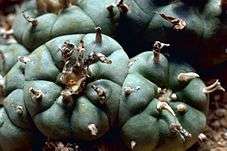Lophophora
| Lophophora | |
|---|---|
 | |
| Lophophora williamsii cluster | |
| Scientific classification | |
| Kingdom: | Plantae |
| (unranked): | Angiosperms |
| (unranked): | Eudicots |
| (unranked): | Core eudicots |
| Order: | Caryophyllales |
| Family: | Cactaceae |
| Subfamily: | Cactoideae |
| Tribe: | Cacteae |
| Genus: | Lophophora J.M.Coult. |
| Species | |
Lophophora is a genus of spineless, button-like cacti native to the southwestern United States (Texas and New Mexico) through Northeast Mexico and South to Querétaro in central Mexico.
The species are extremely slow growing, sometimes taking up to thirty years to reach flowering age (at the size of about a golf ball, excluding the root) in the wild. Cultivated specimens grow considerably faster, usually taking between three and ten years to reach from seedling to mature flowering adult. The slow rate of reproduction and over-harvesting by collectors render the species under threat in the wild.
Taxonomy
Lophophora means "crest-bearing", referring to the tufts of trichomes that adorn each tubercle. The name is derived from the two Ancient Greek words λοφος (lophos, the crest of a hill or helmet) and φορεω (phoreo, to carry).[1] Lophophora has been reported to have two species, L. williamsii and L. diffusa. Other 3 species have being proposed: L. fricii, L. koehresii, and L. alberto-vojtechii. Most modern authorities consider Lophophora to be a genus of two species, L. diffusa and L. williamsii. Recent DNA sequencing studies (Butterworth et al. 2002) have shown that L. diffusa and L. williamsii indeed are distinct species. DNA evidence from the alleged species L. fricii and L. koehresii would allow for more accurate classification.[2]
Below is given a key for the currently accepted species along with the "species" and varieties that must be considered synonymous. Detailed arguments for this classification can be found in Peyote: The Divine Cactus (Anderson 1996, pp. 210–219).
Species
- Lophophora diffusa (Croizat) Bravo : The plants are yellow-green, usually lacking well-defined ribs and furrows. The podaria are rarely elevated, but are broad and flat. The tufts of hair are usually spread unequally on the prominent podaria. The flowers are commonly whitish to yellowish-white. L. diffusa occurs at the south end of the range of the genus in Querétaro state, Mexico. This species contains zero to trace amounts of mescaline; pellotine is the principal alkaloid.
- Several people have reported that this cactus is psychoactive if ingested, though the experience is unlike peyote. This species looks almost identical to peyote, though it is legal to possess in the United States.
- Lophophora williamsii (Lemaire ex Salm-Dyck) J.M.Coult. The plants are blue-green, usually with well-defined ribs and furrows. The tufts of hair are usually equally spaced on the ribs. The flowers are pinkish or rarely whitish. L. williamsii occurs in the full range of the genus except in Querétaro state, Mexico. The mescaline content in dried "Peyote" can reach almost 7%.
Ethnobotany
Lophophora williamsii, commonly known as peyote, is noted for its psychotropic alkaloids. These alkaloids are absent or only found in extremely small amounts in the other species Lophophora diffusa. While L. diffusa is known for having psychoactive effects, these effects are described not so much as "visionary", like peyote, but rather a delirious high such as those associated with the use of Datura and Belladonna. The stem is used as a spiritual hallucinogen, and is applied topically as a galactogogue, or lactation aid .
Lophophora species easily adapt to cultivation, requiring warm conditions and a free-draining substrate, and to be kept dry in winter.
References
- ↑ Liddell, Henry George; Robert Scott (1980). A Greek-English Lexicon (Abridged Edition). United Kingdom: Oxford University Press. ISBN 0-19-910207-4.
- ↑ C. A. Butterworth & J. H. Cota-Sanchez, & R. S. Wallace (2002), ”Molecular systematics of Tribe Cacteae (Cactaceae: Cactoideae): A phylogeny based on rpl16 intron sequence variation”, Systematic Botany 27 (2), 257-270.
- Edward F. Anderson, The Cactus Family (Timber Press, 2001) ISBN 0-88192-498-9, pp. 396–397
- Edward F. Anderson, Peyote: The Divine Cactus (University of Arizona Press; 2nd edition, 1996) ISBN 0-8165-1654-5
- Lyman Benson, Cacti of the United States and Canada (Stanford University Press, 1983) ISBN 0-8047-0863-0, pp. 680–683
- John M. Coulter, Preliminary revision of the North American species of Cactus, Anhalonium, and Lophophora (Contributions from the U. S. National Herbarium 3(2), 1894)
- Rudolf Grym, Rod/Die Gattung Lophophora (Vydavateľstvo Igor Dráb, 1997) ISBN 80-85441-11-X
External links
| Wikimedia Commons has media related to Lophophora. |
- Habitat photos of Lophophora
- Notes on growing Lophophora
- Cultivars photos of Lophophora
- lophophora collection video